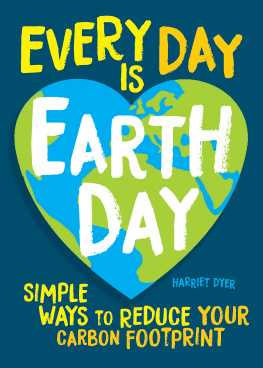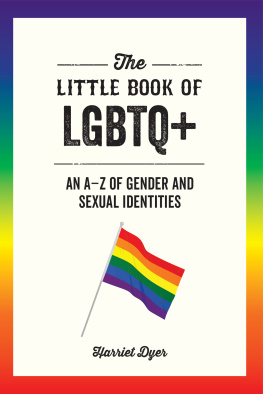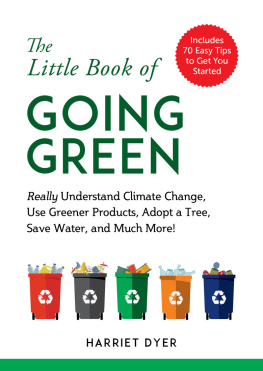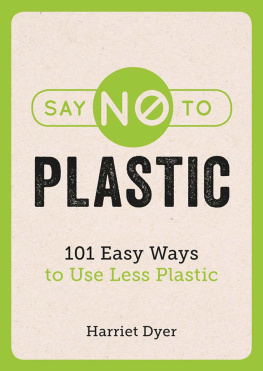Harriet Dyer - Every Day Is Earth Day
Here you can read online Harriet Dyer - Every Day Is Earth Day full text of the book (entire story) in english for free. Download pdf and epub, get meaning, cover and reviews about this ebook. year: 2021, publisher: Andrews McMeel Publishing, genre: Romance novel. Description of the work, (preface) as well as reviews are available. Best literature library LitArk.com created for fans of good reading and offers a wide selection of genres:
Romance novel
Science fiction
Adventure
Detective
Science
History
Home and family
Prose
Art
Politics
Computer
Non-fiction
Religion
Business
Children
Humor
Choose a favorite category and find really read worthwhile books. Enjoy immersion in the world of imagination, feel the emotions of the characters or learn something new for yourself, make an fascinating discovery.
- Book:Every Day Is Earth Day
- Author:
- Publisher:Andrews McMeel Publishing
- Genre:
- Year:2021
- Rating:3 / 5
- Favourites:Add to favourites
- Your mark:
- 60
- 1
- 2
- 3
- 4
- 5
Every Day Is Earth Day: summary, description and annotation
We offer to read an annotation, description, summary or preface (depends on what the author of the book "Every Day Is Earth Day" wrote himself). If you haven't found the necessary information about the book — write in the comments, we will try to find it.
Every Day Is Earth Day — read online for free the complete book (whole text) full work
Below is the text of the book, divided by pages. System saving the place of the last page read, allows you to conveniently read the book "Every Day Is Earth Day" online for free, without having to search again every time where you left off. Put a bookmark, and you can go to the page where you finished reading at any time.
Font size:
Interval:
Bookmark:


EVERY DAY IS EARTH DAY
Copyright 2021 by Summersdale Publishers Ltd. All rights reserved. No part of this book may be used or reproduced in any manner whatsoever without written permission except in the case of reprints in the context of reviews.
Andrews McMeel Publishing
a division of Andrews McMeel Universal
1130 Walnut Street, Kansas City, Missouri 64106
www.andrewsmcmeel.com
First published as How to Reduce Your Carbon Footprint in 2020 by Summersdale Publishers Ltd.
Part of Octopus Publishing Group Limited
46 West Street
Chichester, West Sussex
PO19 1RP
United Kingdom
ISBN: 978-1-5248-7016-4
Library of Congress Control Number: 2020944160
Editor: Kevin Kotur
Art Director: Diane Marsh
Production Manager: Tamara Haus
Production Editor: Margaret Daniels
Ebook Production: Kristen Minter
ATTENTION: SCHOOLS AND BUSINESSES
Andrews McMeel books are available at quantity discounts with bulk purchase for educational, business, or sales promotional use. For information, please e-mail the Andrews McMeel Publishing Special Sales Department: .
What is a carbon footprint?
We know that the main factor causing climate change today is the release of greenhouse gases, such as carbon dioxide (CO ), into the atmosphere by human beings. But what is a carbon footprint? The term has gained a lot of traction over the past few years as an analogy when measuring the amount of greenhouse gases that people emit through various activities. Some activities have a carbon footprint that is created by one person, but others have a footprint that includes a complex chain of individuals and organizations.
Take, for example, a basic cotton T-shirt that was manufactured in another country. If you purchase it, at first glance the only emissions you might think you are accountable for are from traveling to and from the store (if you ride in a vehicle that emits CO ). But the indirect carbon emissions (i.e., the ones that dont originate directly from you) that are linked to the T-shirt make your overall footprint a lot bigger. From the energy and water used to grow the raw material and manufacture the garment, to shipping the item and storing it in a warehouse or store, your indirect carbon footprint is the equivalent of approximately twenty pounds (or nearly ten kilograms)think five two-liter bottles of sodaof CO being released into the atmosphere.
Unfortunately, we live in a world where its impossible not to leave a carbon footprinteven drinking water leaves a trace! However, understanding more about your direct and indirect carbon emissions will help you to make more informed decisions on how you can live a greener life.
What can I do?
With a problem thats so huge, its easy to feel powerless and disheartened. But the truth is that small changes and actions can have big effects, because they all add up.
From finding out more about the crisis we are facing to learning ways in which you can make simple changes to your daily routine thatll make a big environmental difference, these pages will be your guide to a more eco-friendly life. Surprise your colleagues and acquaintances with carbon footprint facts, share the book with friends and family, and do everything in your power to get the message across that we must act now if we are going to help save future generations from climate catastrophe. There is still hopeso lets not give up the battle until we see some positive results... and then lets keep going.
This book is quite data-heavy, but data can lose its impact if we dont have a way of picturing it. So, before we delve into the following chapters, here are some ways to visualize the big numbers youll come across.
1 lb (.45 kg) = approx. two cups (roughly half a liter) of water
100 lb (45 kg) = approx. an adult chimpanzee
1 tnor 2,000 lb (907 kg) = approx. one small car
150 tn (136,078 kg) = approx. a blue whale
1 acre (.41 hectares) = approx. of an American football field
1 gigatonor 1,000,000,000 tn (two trillion pounds) = approx. six million blue whales

 We are the first generation to feel the sting of climate change, and we are the last generation that can do something about it.
We are the first generation to feel the sting of climate change, and we are the last generation that can do something about it. 
Jay Inslee
In this chapter you can find out about the effects that our collective carbon footprint is having on the planet, from unusual climate and weather patterns, as well as changes to the atmosphere, to the rise of sea levels and forest depletion. Its your one-stop shop to discovering more about climate change.

We know its there, but because it cant be seen with the naked eye, we often forget all about our atmosphere and the air that surrounds us and keeps us alive. Unfortunately, in this case, whats out of sight is out of mind. Its time to make the invisible visible as we look at some of the key facts and stats on how our massively oversized carbon footprint is changing the planets climate, weather, and atmosphere.

2019 was the second hottest year on record.
Hottest years on record (in order): 2016, 2019, 2015, 2017, 2018.
Since 1981, the global annual temperature has increased by 0.32F (0.18C) year.
At the time of writing, it is forecast to increase another two degrees within the next twenty to thirty years and over four degrees by 2100, on average.

Global precipitation has increased at an average rate of nearly an inch (2 cm) per decade since 1901.
The number of floods and periods of heavy rain has quadrupled since 1980 and doubled since 2004.

In North America, the length of time when snow covers the ground has become shorter by nearly two weeks since 1972. In the Northern Hemisphere, snow cover has decreased by 5 percent annually, from 1966 to 2005.
USA
 In 2019, there were over 120,000 extreme weather records, including snow in Hawaii and heatwaves in Alaska.
In 2019, there were over 120,000 extreme weather records, including snow in Hawaii and heatwaves in Alaska.

 The country had rainfall 4.7 in (12 cm) above average in 2019.
The country had rainfall 4.7 in (12 cm) above average in 2019.

Font size:
Interval:
Bookmark:
Similar books «Every Day Is Earth Day»
Look at similar books to Every Day Is Earth Day. We have selected literature similar in name and meaning in the hope of providing readers with more options to find new, interesting, not yet read works.
Discussion, reviews of the book Every Day Is Earth Day and just readers' own opinions. Leave your comments, write what you think about the work, its meaning or the main characters. Specify what exactly you liked and what you didn't like, and why you think so.













